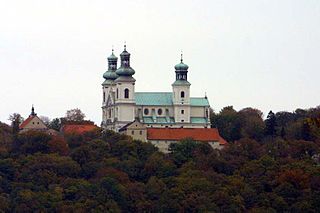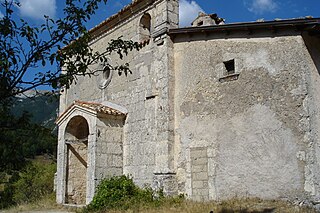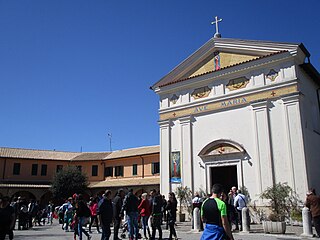
The Camaldolese Hermits of Mount Corona, commonly called Camaldolese, is a monastic order of Pontifical Right for men founded by Saint Romuald. Its name is derived from the Holy Hermitage of Camaldoli, high in the mountains of central Italy, near the city of Arezzo. Its members add the nominal letters E.C.M.C. after their names to indicate their membership in the congregation. Apart from the Roman Catholic monasteries, in recent times ecumenical Christian hermitages with a Camaldolese spirituality have arisen as well.

Pretoro is a town of about 1,100 inhabitants situated in Majella National Park, in the province of Chieti, Abruzzo, southern Italy. It is located on a steep hillside on the eastern side of the Maiella mountains. Its proximity to Passo Lanciano-La Majelletta ski area, guarantees the availability of winter sports, while the town is also only 20 minutes by car from the Adriatic Sea. It is one of I Borghi più belli d'Italia.

The Hermitage of Camaldoli, in Italian Complesso dell'Eremo dei Camaldoli, is a hermitage in Naples, Campania, Italy — also known in Italian as Eremo Santissimo Salvatore Camaldoli. Originally intended as an actual hermitage, a place for religious seclusion for male ascetics, the complex has served Brigidine nuns since 1998. The complex is located at Via dell'Eremo 87, at an elevation of 458 meters (1502'), the highest point in Naples.

Tourism in Abruzzo has become one of the most prosperous sectors in the economy of Abruzzo, and in recent years has seen a remarkable growth attracting numerous tourists from Italy and Europe. According to statistics, in 2021 arrivals totaled 1,330,887. A total of 5,197,765 arrivals were tourists, a figure that puts the region seventeenth among the Italian regions for numbers of tourists per year. A moderate support to tourism is also given to the Abruzzo Airport with many low cost and charter flights connecting the entire region with the rest of Europe.

The Abbey of the Holy Spirit at Morrone, known by various titles, is a former monastery some five kilometers outside of the town of Sulmona, at the base of Monte Morrone, in the Province of L'Aquila, region of Abruzzo, Italy.

Abbazia di San Bartolomeo is a Benedictine abbey in Carpineto della Nora, Province of Pescara (Abruzzo). It was declared a national monument in 1902.

Eremo di San Domenico is an hermitage located in Villalago, Province of L'Aquila.

Eremo di Sant'Egidio is an hermitage located in Scanno, Province of L'Aquila. It is located on the hill of the same name and dedicated to the Sant'Egidio.

Eremo di San Giovanni all'Orfento is an hermitage located in Caramanico Terme, Province of Pescara.

Eremo di Sant'Angelo is an hermitage located in Palombaro, Province of Chieti.

Eremo della Madonna dell'Altare is an hermitage located in Palena, Province of Chieti.

Eremo della Madonna di Coccia is an hermitage located in Campo di Giove, Province of L'Aquila.

Eremo di San Michele Arcangelo is an hermitage located in Pescocostanzo, Province of L'Aquila.

Eremo di Santo Spirito a Majella is an hermitage located in Roccamorice, Province of Pescara.

Eremo di Sant'Onofrio al Morrone is an hermitage located in Sulmona, Province of L'Aquila ., dating back to the thirteenth century. A monk by the name of Pietro Angelerio living at this hermitage later became Pope Celestine V. The hermitage is located at an altitude of 620 meters, and can only be reached via a steep path from the village of Badia, on the eastern edge of the Valle Peligna.

Complesso rupestre di San Liberatore is a rock-cut architecture located in Serramonacesca, Province of Pescara.

The Piani Palentini is a plateau in upper Marsica, a subregion of Abruzzo, in central Italy.

The Sanctuary of the Madonna di Pietraquaria is a church situated on Mount Salviano at about 1,000 metres ASL in the municipal territory of Avezzano, Abruzzo, Central Italy.

Muzio Febonio was an Italian priest and historian, best known for his historical and hagiographic works about Marsica, the Abruzzo sub-region where he was born. In his writings he made extensive use of archive documents and historiographic and archaeological sources, showing a deep knowledge of them, although in a somewhat formal and pedantic style. However, his works represent a valuable source of information for later historians, even if their publication occurred with a lot of errors and delays, which partly explains the limited fame this author enjoyed.

The Riserva Naturale di Monte Salviano or Riserva naturale guidata Monte Salviano is a nature reserve in Abruzzo, Italy, established in 1999. It lies in the territory of the comune (municipality) of Avezzano, in the Province of L'Aquila. The reserve is named after Monte Salviano, a massif that extends northwest to southwest dividing the Fucine basin from the Palentine Plains, in the Marsica sub-region.




















